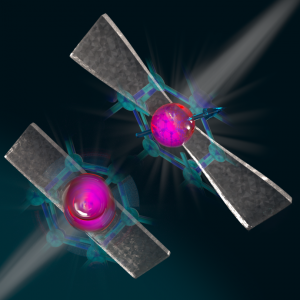Nov. 30, 2023 — A future quantum network may become less of a stretch thanks to researchers at the University of Chicago, Argonne National Laboratory and Cambridge University.

A team of researchers announced a breakthrough in quantum network engineering: By “stretching” thin films of diamond, they created quantum bits that can operate with significantly reduced equipment and expense. The change also makes the bits easier to control.
The researchers hope the findings, published Nov. 29 in Physical Review X, can make future quantum networks more feasible.
“This technique lets you dramatically raise the operating temperature of these systems, to the point where it’s much less resource-intensive to operate them,” said Alex High, assistant professor with the Pritzker School of Molecular Engineering, whose lab led the study.
Diamond Dilation
Quantum bits, or qubits, have unique properties that make them of interest to scientists searching for the future of computing networks—for example, they could be made virtually impervious to hacking attempts. But there are significant challenges to work out before it could become a widespread, everyday technology.
One of the chief issues lies within the “nodes” that would relay information along a quantum network. The qubits that make up these nodes are very sensitive to heat and vibrations, so scientists must cool them down to extremely low temperatures to work.
“Most qubits today require a special fridge the size of a room and a team of highly trained people to run it, so if you’re picturing an industrial quantum network where you’d have to build one every five or 10 kilometers, now you’re talking about quite a bit of infrastructure and labor,” explained High.
High’s lab worked with researchers from Argonne National Laboratory, a U.S. Department of Energy national lab affiliated with UChicago, to experiment with the materials these qubits are made from to see if they could improve the technology.
One of the most promising types of qubits is made from diamonds. Known as Group IV color centers, these qubits are known for their ability to maintain quantum entanglement for relatively long periods, but to do so they must be cooled down to just a smidge above absolute zero.
The team wanted to tinker with the structure of the material to see what improvements they could make—a difficult task given how hard diamonds are. But the scientists found that they could “stretch” out the diamond at a molecular level if they laid a thin film of diamond over hot glass. As the glass cools, it shrinks at a slower rate than the diamond, slightly stretching the diamond’s atomic structure—like pavement expands or contracts as the earth cools or warms beneath it, High explained.
Big Impact
This stretching, though it only moves the atoms apart an infinitesimal amount, has a dramatic effect on how the material behaves.
First, the qubits could now hold their coherence at temperatures up to 4 Kelvin (or -452°F). That’s still very cold, but it can be achieved with less specialized equipment. “It’s an order of magnitude difference in infrastructure and operating cost,” High said.
Secondly, the change also makes it possible to control the qubits with microwaves. Previous versions had to use light in the optical wavelength to enter information and manipulate the system, which introduced noise and meant the reliability wasn’t perfect. By using the new system and the microwaves, however, the fidelity went up to 99%.
It’s unusual to see improvements in both these areas simultaneously, explained Xinghan Guo, a Ph.D. student in physics in High’s lab and first author on the paper.
“Usually if a system has a longer coherence lifetime, it’s because it’s good at ‘ignoring’ outside interference—which means it is harder to control, because it’s resisting that interference,” he said. “It’s very exciting that by making a very fundamental innovation with materials science, we were able to bridge this dilemma.”
“By understanding the physics at play for Group IV color centers in diamond, we successfully tailored their properties to the needs of quantum applications,” said Argonne National Laboratory scientist Benjamin Pingault, also a co-author on the study. “With the combination of prolonged coherent time and feasible quantum control via microwaves, the path to developing diamond-based devices for quantum networks is clear for tin vacancy centres,” added Mete Atature, a professor of physics with Cambridge University and a co-author on the study.
The researchers used the Pritzker Nanofabrication Facility and Materials Research Science and Engineering Center at UChicago.
Other study authors included Zixi Li, Benchen Huang, Yu Jin, Tianle Lu, Prof. Giulia Galli and Prof. David Awschalom with the University of Chicago; Nazar Delegan and Benjamin Pingault with Argonne National Laboratory; and Alexander Stramma (co-first author), William Roth, Ryan Parker, Jesus Arjona Martinez, Noah Shofer, Cathryn Michales, Carola Purser, Martin Appel, Evgeny Alexeev, and Andrea Ferrari with the University of Cambridge.
Funding: Air Force Office of Scientific Research, U.S. Department of Energy Q-NEXT National Quantum Information Science Research Center, ERC Advanced Grant PEDASTAL, EU Quantum Flagship, National Science Foundation, EPSRC/NQIT, General Sir John Monash Foundation and G-research, Winton Programme and EPSRC DTP, EU Horizon 2020 Marie Sklodowska-Curie Grant.
Source: Louise Lerner, UChicago


























































